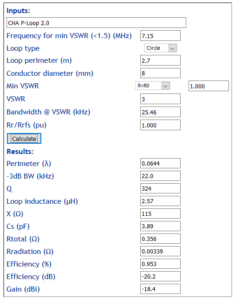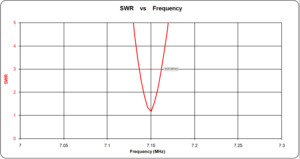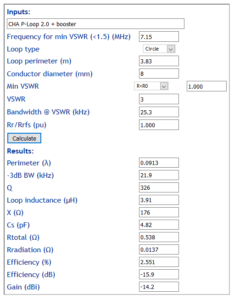Chameleon have released their CHA-P-Loop 2.0 small transmitting loop. This article considers the likely efficiency on 40m based on their published measurements and Efficiency and gain of Small Transmitting Loops (STL).
Description
The antenna is described at http://chameleonantenna.com/CHA%20P-LOOP%202.0/CHA%20P-LOOP%202.0.html.
This analysis does not consider the proprietary Power Compensator option for lack of sufficient information.
The loop itself appears to be LMR400 coax or similar (nominally 8.0mm outer conductor diameter) in a rough circle of 34″ (0.863m) diameter.
Little information is given of the internals, but the promotional material gives a VSWR curve for a matched antenna at 7.15MHz. To their credit, they give the height above ground and ground type for their tests, though elevation above ground was between 1/2 diameter to a full diameter of the P-LOOP 2.0
is a little vague.
Basic loop (34″)
The VSWR=3 bandwidth scaled from the graph is 27.0kHz. The shape of the curve near minimum suggests that were the scan points sufficiently close, the minimum VSWR would be very close to 1.0 and it is taken as 1.0.
If we assume for a moment that the VSWR measurement was captured at a substantial height above ground, its behaviour approaches that of the antenna in free space. Taking the assumption that the published curve is similar to the antenna in free space, we can estimate the gain and efficiency based on earlier assumptions.
The assumed values and published VSWR curve indicate an antenna system half power bandwidth of 22.0kHz and Q of 324 which implies efficiency of 0.95% (-20.2dB).
The actual value for radiation resistance is likely to be with -50-+100% of the free space value used, and that rolls up as an uncertainty of +/-3dB in the calculated efficiency and gain.
The estimated efficiency is considerably lower than Chameleon’s specified 5.67%, but they offer no justification for that value.
With booster kit (48″)
The VSWR=3 bandwidth scaled from the graph is 25.3kHz. The shape of the curve near minimum suggests that were the scan points sufficiently close, the minimum VSWR would be very close to 1.0 and it is taken as 1.0.
If we assume for a moment that the VSWR measurement was captured at a substantial height above ground, its behaviour approaches that of the antenna in free space. Taking the assumption that the published curve is similar to the antenna in free space, we can estimate the gain and efficiency based on earlier assumptions.
The assumed values and published VSWR curve indicate an antenna system half power bandwidth of 21.9kHz and Q of 326 which implies efficiency of 2.55% (-15.9dB).
The actual value for radiation resistance is likely to be with -50-+100% of the free space value used, and that rolls up as an uncertainty of +/-3dB in the calculated efficiency and gain.
The estimated efficiency is considerably lower than Chameleon’s specified 14.4%, but they offer no justification for that value.
Efficiency comparison
The booster kit increases diameter by 48/34=1.41 times, and for a STL, that implies an increase in Rr of dia^4=4 times.
If all other losses were constant, for such a loop an increase in Rr by a factor or 4 would increase efficiency by close to the same amount. But, some losses will increase significantly for the larger loop, and it seems unlikely that efficiency would increase by quite 4 times.
The calculator suggests the likely efficiency improvement was around 2.7 times which is credible.
The comparison shows how sensitive efficiency is to diameter when the loop perimeter is less than λ/10.
At some point though there is a trade-off between size and performance, and indeed the 48″ loop on 7MHz only just qualifies as a STL where the conventional formula for Rr is sufficiently accurate for most purposes (perimeter is less than λ/10).
Conclusions
Chameleon gives sufficient information on their ‘basic’ CHA-P-Loop 2.0 to allow a reasonable estimate of its efficiency on 40m to be 0.95% (-20.2dB) +/-3dB.
Chameleon gives sufficient information on their CHA-P-Loop 2.0 with 48″ booster kit to allow a reasonable estimate of its efficiency on 40m to be 2.55% (-15.9dB) +/-3dB.
References / links
- Chameleon. nd. CHA P-LOOP 2,0. http://chameleonantenna.com/resources/CHA_M-LOOP_SWR_ANALYSIS.pdf (accessed 16/04/2017).
- Duffy, O. May 2014. Small transmitting loop calculators – a comparison. https://owenduffy.net/blog/?p=1693.
- Duffy, O. Nov 2014b. Chameleon CHA M-LOOP. https://owenduffy.net/blog/?p=2999.
- Efficiency and gain of Small Transmitting Loops (STL)
- Small transmitting loops
- Yates, S. April 2009. Small Magnetic Loop Antenna Calculator ver. 1.22a.



